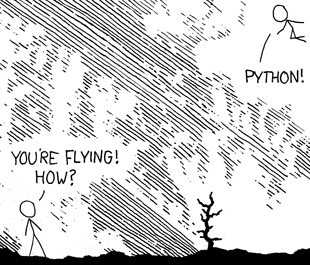This guide on hacking wordpress templates is the best I have seen. It’s succinct and covers enough breadth to be of general use without ranging too far afield into esoterica.
Author: fledgling otaku
-
The Golden Compass
This movie is based on Philip Pullman’s His Dark Materials trilogy, and premieres tomorrow. I haven’t read the original series, but it’s come under significant criticism from religious groups like the Catholic League who argue that the film “sells atheism to kids” (There’s a a good summary of the controversy, with refs, at Wikipedia). Not having read the books, I can’t comment on the fracas, but I am in general skeptical (the ridiculous brouhaha about The DaVinci Code comes immediately to mind). What interests me more however is the movie, and from the looks of it, it’s in every sense the heir to Lord of the Rings with respect to epic scale and visual feast. The first five minutes of the film are online at Yahoo and are a must-see. A pair of positive reviews at AICN – by liberal Harry, and by conservative Massawyrm, who addressed the controversy, also are worth reading. Standing alone, this film is incomplete; in a sense it’s like Fellowship of the Ring which is really act 1 of a 6-hour movie. But that’s the price we pay for a truly epic scale.
Intriguingly, it seems that Prince Caspian, the sequel movie to The Lion, The Witch and the Wardrobe is also in the works. It’s interesting to see this new film genre of child-friendly epic fantasy is evolving, and is populated not just with classic literature (two of the Inklings!) but also with more modern works like Pullman’s and of course Harry Potter – and how they come at the questions of faith and freedom from opposite directions, yet all converge.
-
Galactica: Razor
I have to admit, it was nice seeing Galactica on screen again, but Razor on the whole left me fairly unsatisfied. I had hoped for a more gritty look at the realities faced by the Pegasus, and wanted to see some justification for the general conceit of the Pegasus crew that they had it worse and had to make tough choices… (more…)
-
Python
I used to be a Perl hacker. I confess I’ve forgotten a lot of the zen since, and nowadays I’m more a PHP guy (or MATLAB). But I’ve been hearing a lot about Python (ever since the infamous Parrot April Fool’s joke). The XKCD comic excerpted below got me thinking though that maybe I should get familiar with it in a more formal sense. Anyone out there use Python regularly? How does it compare, as a scripting language, to Perl? How does it compare, as a web application language, to PHP?
-
my anime watchlist
AICN has a synopsis of the plot of the anime “Death Note” that makes it sound really quite intriguing:
The titular Death Note is a note pad of a shinigami (death god, comparable to the notion of a grim reaper), which allows its owner to dictate the time and cause of death for the victim whose name is inscribed on one of its pages. This is a very rule based process, starting with the clause that if no cause is specified within 40 seconds, the victim will die of a heart attack, and getting more complex from there.
Bored by the listlessness of his people, the shinigami Ryuk decides to amuse himself by dropping a Death Note into the human world. There, it is picked up by ace student Light Yagami. To Ryuk’s amusement, Light proves unphased by the power to kill, the revelation that shinigami exist, or that using the Death Note ensures that a human will neither travel to heaven or hell upon death. After using the book to kill, the only repercussion incurred is that the user’s name will be written in the book by its original shinigami owner upon the user’s death.
When it comes to shock, Light is revealed to have iron fortitude. After the ability to kill on a whim is dropped into his lap, he proves able to compose himself and push forward with his agenda.
The certainty with which he embraces that power makes Light an intriguing character.
The description of Light as a character both arrogant and idealistic make for a very righteous archetype, like a paladin convincing himself of the greater good and a ends-justify-means crusade. I am reminded of the Kingpriest from Dragonlance Chronicles as well. At any rate, I’ll see if I can find the torrents for this one.
I am also determined to watch Sayonara Zetsubou Sensei – though from what I read at Astro’s, its unclear if the fansubbers will finish subbing season 1. I’m also fascinated by the premise of Moyashimon, which has the visual appeal of a science lab on LSD. My friend Jon also dropped by Marshfield on his way home to Appleton from the Twin Cities, and brought Read or Die (the pilot as well as the full season), Ranma, Ergo Proxy, FateStayNight, Gankutsuou, Noir, and Samurai7. That’s a feast of anime that should keep me and my baby daughter fed through the holiday season (I typically watch anime while bottle-feeding her; we both just zone out and do our respective thing). Suggestions as to which I should tackle first are welcome (and requested).
I also have to get off my arse and write something about The Girl who Leapt, Twelve Kingdoms, and (waaaay overdue) Someday’s Dreamers. However, of late I’ve been distracted by something decidedly non-anime: Heroes. More on that later 🙂
-
unreal Great White shark photos
If you’ve seen the Planet Earth series on DVD (or even better, high-definition DVD) then you’ll recall the astounding footage of a great white shark hunting seals for food, leaping out of the water like a leviathan and twisting in midair while it lunges towards its prey. Now you don’t need the DVD – check out this astounding hi-speed photography of a great white hunt. These pictures are simply awesome. In the original sense of the word.
-
woah, that’s like deep
Surfer dude comes up with the Theory of Everything?
An impoverished surfer has drawn up a new theory of the universe, seen by some as the Holy Grail of physics, which has received rave reviews from scientists.
[…]
Despite this unusual career path, his proposal is remarkable because, by the arcane standards of particle physics, it does not require highly complex mathematics.Even better, it does not require more than one dimension of time and three of space, when some rival theories need ten or even more spatial dimensions and other bizarre concepts. And it may even be possible to test his theory, which predicts a host of new particles, perhaps even using the new Large Hadron Collider atom smasher that will go into action near Geneva next year.
Although the work of 39 year old Garrett Lisi still has a way to go to convince the establishment, let alone match the achievements of Albert Einstein, the two do have one thing in common: Einstein also began his great adventure in theoretical physics while outside the mainstream scientific establishment, working as a patent officer, though failed to achieve the Holy Grail, an overarching explanation to unite all the particles and forces of the cosmos.
Intriguingly, the theory apparently has something to do with “E8“, an 8-dimensional mathematical shape with 248 points that pops up in theoretical physics and in nature. So, the universe might well look like this, in a sense:
There’s a lot more information about E8 at the American Institute of Math – including some clever marketing text describing E8’s mysteries as containing more information that the human genome, and the calculations delving into its nature being the size of Manhattan if written out in tiny print on paper.

